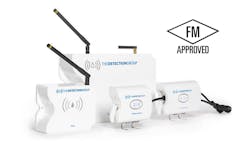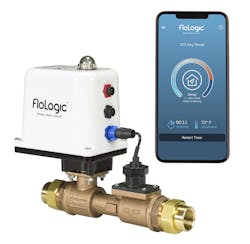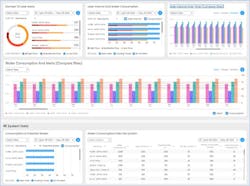Leak detection is big business—which is no surprise, since it's big money. Plumbing leaks are responsible for more than $13 billion in claims paid by US insurance companies each year. About 8.1% of homes in the US will experience a plumbing leak each year—1 in 12. Compared to burglary (1 in 36) and fire (1 in 333), water damage is by far the most likely.
Aside from direct damage, and even mold damage (which can jeopardize future insurance coverage), consider the money lost from the leak itself. According to the US EPA roughly 12% of water entering homes is wasted due to leaks. Money down the drain!
All of this can be prevented with a properly installed leak detection system. There are a wide variety of solutions available with different methods, features and price points. The following list by no means exhaustive, but should give you some idea of what's available.
Lync by Watts
When Trident’s wireless sensors detect a water leak it immediately communicates the precise location so a property owner or building manager can take action. Trident is the first and only wireless water leak detection platform to receive FM Approval.
When a leak occurs, Trident will set off an on-site audible alarm and uses its own secure RF network to send out real-time phone, email, and text alerts. The system can watch hundreds of locations within a single building. A remote management platform allows the user to update and monitor the status of the system from home or the office.
FloLogic
The FloLogic system monitors all water flow events starting as small as a half-once of flow per minute in real time. Normal water use is episodic, whereas leaks cause abnormal continuous flow. FloLogic’s Home and Away modes flag abnormal flow events based on property occupancy and automatically shuts off the water to prevent catastrophic leak damage. FloLogic bills itself as the only flow-based system that can precisely see and therefore catch small leaks in real time (meter-based technologies have a real time low flow blind spot).
FloLogic’s flow sensitivity can be adjusted to begin monitoring from 0.5 to 48-plus ounces-per-minute, allowing the system to ignore the small trickle of water required for evaporative humidifiers or for a leaky faucet that hasn’t been fixed.
FloLogic comes equipped with battery backup and the ability to integrate with security systems and automated water-use devices such as irrigation systems as a standard feature. FloLogic’s integrated low temp sensor will alert the user when the room temperature reaches a user-set level and will automatically shut off the water at a programmed temperature to prevent frozen pipe leak damage.
Installing is very similar to installing a traditional manual valve. The system plugs into a 110-volt outlet for power. FloLogic also offers contractors attractive dealer pricing that helps improve the profitability of installing leak detection.
Mikrofill by Stuart Turner
Unlike “pump type” pressurization units the Mikrofill 3 is designed to be connected directly to a buildings incoming mains/boosted water supply and fill a heating or chilled water system without the use of a pump. The Mikrofill 3 consumes as little as 10 watts/hr on standby and 30 watts/hr fully operational.
The Mikrofill 3 pressurization unit incorporates:
- Fluid Risk Category 4 backflow prevention
- The ability to fill directly from mains/ boosted water supply any LPHW or CHW system from empty
- Comprehensive electronic pressure management
That comprehensive electronic pressure management operates, naturally, as a leak detection system. The Mikrofill 3 acts on a drop in the system pressure, the sensitivity of which can be set to suit the specific needs of the application site. If the MK3 detects a drop below that of the commissioned coldfill setting, the unit will allow mains water to enter the system to compensate for a given time (which, again, can be set to suit the site specifics).
If the preset target is not achieved during the given time frame, the unit will go to fault and a signal will be sent to the connected plant (the boiler, for example). If a catastrophic leak occurs (an immediate drop in system pressure that shoots straight to the low-level alarm), the MK3 will isolate the connected plant.
The system alerts registered by the MK3 initially switch off the connected plant and can, if installed, convey a fault message to a building management system to inform remote monitoring staff.
WINT
The system alerts the user when water is leaking and can automatically shut it off. Intelligent real-time monitoring identifies sources of leaks and waste preventing damage, reducing consumption and cutting the resulting carbon emissions. The system offers unparalleled anomaly detection and analytics, as well as enterprise-grade management for operation in large and mid-sized facilities. Other features include:
- Backup power to ensure uninterrupted water management and valve activation even during power outages.
- Autonomous operation in case of communication failures.
- Flexible communication options, including Wi-Fi, Ethernet, 4G and 5G cellular.
- Ability to monitor and detect anomalies on all types of water systems in the facility, including main feeds, domestic cold water, irrigation, cooling towers, sprinklers, and HVAC.
The WINT system is constantly collecting data in a manner that allows users to continuously improve the water footprint of their buildings, which can result in impressive water savings (as much as 25% of water bills).
About the Author
Steve Spaulding
Editor-in-Chief - CONTRACTOR
Steve Spaulding is Editor-in-Chief for CONTRACTOR Magazine. He has been with the magazine since 1996, and has contributed to Radiant Living, NATE Magazine, and other Endeavor Media properties.




